#On the Genealogy of Morality
Quote
As is well known, the priests are the most evil enemies — but why? Because they are the most impotent. It is because of their impotence that in them hatred grows to monstrous and uncanny proportions, to the most spiritual and poisonous kind of hatred.
Friedrich Nietzsche, On the Genealogy of Morality
83 notes
·
View notes
Text

#philosophy#quotes#Friedrich Nietzsche#On the Genealogy of Morality#Nietzsche#self#knowledge#understanding#awareness
20 notes
·
View notes
Text
“Sometimes people don't want to hear the truth because they don't want their illusions destroyed.”

Friedrich Nietzsche was a German philosopher, prose poet, and cultural critic.
Born: 15 October 1844, Röcken, Lützen, Germany
Died: 25 August 1900, Weimar, Germany
#Philosopher#Existentialism#Nihilism#Ethics#Will to power#Übermensch (Superman)#Eternal recurrence#Amor fati (Love of fate)#Genealogy of morals#Beyond good and evil#Dionysian/Apollonian#Critique of religion#Truth and knowledge#The death of God#Perspectivism#Master-slave morality#Art and aesthetics#Human nature#Individualism#Free will#today on tumblr#quoteoftheday
2 notes
·
View notes
Text
Edge is thin so they're generally very smelly, Which creates the perceived rudeness comes from their fight skills, their Man muscle, their Cocks and balls and their moral genealogy is revealed at THE outset when it is a common name OF his shop. the Zelda and mario series are created on the same categories as official art
#TEXT#DAY 15#we'll make diamonds from their fight skills#their man muscle#their cocks and balls and their moral genealogy is revealed at the outset when it veiled its more likely than You think. Do you like any ot
2 notes
·
View notes
Text
every few months since finishing Beyond Good and Evil I re-remember how funny that book was. one chapter devoted to asking "is there anyone bold enough to do real philosophy anymore?", one chapter devoted to poems about girls going to Jupiter to get more stupider
1 note
·
View note
Text
A Note on The Genealogy of Morals by Friedrich Nietzsche
The first time I encountered a philosopher named Friedrich Nietzsche, I was made aware of the pitiful life he had led: the love interest that never really took off, a desirous quest into the abyss, the solitary search for meaning in life, and a decade long entrapment in mental facilities, only to end with a sad death in 1900 CE. Unlike many of our lives, whose meaning ceases to exist after our…

View On WordPress
#ascetic priest and christianity#bad conscience#book review genealogy of morals#books of friedrich nietzsche#genealogy of morals#guilt#ideas of friedrich nietzsche#ideas of nietzsche#man would rather will nothingness than to will at all#master morality#morality critique of nietzsche#nietzsche#notes on genealogy of morals#overman#ressentiment#slave morality#slave morality and ressentiment#summary of genealogy of morals by nietzsche#superhuman of nietzsche#the genealogy of morals review#ubermensch#what is good and bad#what is good and evil according to nietzsche#what is the meaning of ascetic ideals?#will to power
0 notes
Text
Exploring the 18 Puranas in Hindu Dharma: Mythology, Cosmology, and Moral Teachings
The Puranas are a collection of ancient texts that play a significant role in Hindu dharma, providing valuable insights into mythology, cosmology, genealogy, legends, and moral teachings. Composed in Sanskrit, the Puranas are divided into two categories: the Mahapuranas (major Puranas) and the Upapuranas (minor Puranas). In this comprehensive article, we will explore all 18 Puranas, shedding…

View On WordPress
#Ancient Texts#cosmology#Genealogy#Hindu Dharma#Hindu Scriptures#legends#Moral Teachings#mythology#Puranas
0 notes
Note
Does Hellenism have a Holy Book? Or like a Bool with Rules,Customs,Offerings etc?? Kinda like a Bible :>
Hey there, sunshine! ☀️
Hellenic paganism doesn't have one single piece of holy scripture like Abrahamic religions do. Our texts are a little more scattered. We have the Homeric Hymns and the Orphic Hymns, each are a collection of hymns and prayers to the gods. There is also Hesiod's Theogony, an epic 1000+ line poem that details the genealogies of the gods, and also Hesiod's Works and Days, which is more on the subject of morality and farming, but includes good lessons on how to interact with the gods.
You can buy these online in the forms of physical books, but there should also be free pdf versions of them out there, as well as websites that have the entire collection of hymns written out.
As for a text that gives instructions regarding customs and offerings, there isn't one set, singular text that I know of. We learn from historical and archaeological research, from writings like those listed above, and from each other. There are modern books on Hellenic paganism and its practices written by scholars that you could look for. Some are expensive though, and if you do enough digging on the internet yourself, you should be able to come up with some information.
I could teach you a couple basics right now.
1. Be clean when praying
There is a line in Hesiod's Works and Days that reads, "Never pour a libation of sparkling wine to Zeus after dawn with unwashen hands, nor to others of the deathless gods."
This line refers to the custom of washing our hands before giving offerings or libations to the gods. There is a water we make, I think with burnt herbs in it, called khernips that is used to clean our hands. You don't have to use it though (I don't) and simply washing your hands normally works just as well. I believe it also symbolises being generally clean. Being ready for your day and in a good state when presenting yourself to the gods is important, I think.
2. How to pray
Here is a post I found about how to pray in Hellenic paganism. I found it very helpful and I've been pagan for years now, so I think it could help you. (Link)
Also a note, we have a version of "amen" that can be said at the end of prayers, if that sense of closing off makes prayer easier for you. I know it did for me. The word is "khaire", and as I understand it, it means "blessings" or "good wishes". You can say it to someone or to close a prayer.
EDIT: "Khaire" or "khairete" can be used. They both mean "hail" or "farewell" or "blessings". "Khaire" is to address one, and "khairete" is to address a group.
3. Ouranic and chthonic
Quick run down on ouranic and chthonic. Ouranic means celestial, and it is how we refer to gods who live on the surface and in Olympus. These include Zeus, Hera, Apollo, Aphrodite, etc. Chthonic means underground, and it is used to refer to gods who live in the Underworld. These are Hades, Persephone (half the year at least), and Thanatos.
In Ancient times, offerings to ouranic deities were either libations poured to them in a bowl or cup or the smoke of burning food. It is believed that the essence of the food would be carried up to the gods through the smoke. Looking at this in modern day, incense smoke is an excellent offering and we can leave food offerings and libations out on the altar along with a lit candle.
Offerings to chthonic deities usually went in the ground, so that it may be absorbed through the earth and reach the gods in the Underworld that way. Usually libations were poured out on the ground and food offerings buried in a dug hole. If you have a garden or pot plants and your offerings are safe for them then the practice can be replicated that way. I've also seen people use boxes on the altar, putting offerings inside and closing it, symbolising burying it.
Or you can simply treat chthonic deities the same as ouranic deities when giving offerings. Whatever works best for you, but this is what was done traditionally.
4. Read the myths
Read the myths of the gods you wish to worship. You learn a lot and can come to your own conclusions about your worship by learning about their stories and roles in society.
This may all seem like a lot now, and not having one singular piece of decisive scripture can be challenging if you're used to having one, but it does get easier. You'll settle and find your feet. Knowing these things will become second nature, and you will build your own practice based on them. No one's worship looks the same, especially with paganism, and that's as it should be.
Thank you so much for asking, sunshine! So sorry for the long response, but I figured I'd rather leave you with some starting points and things to investigate. Please feel free to send another ask or dm me in future if you have any more questions.
Khaire! ☀️
#answered asks#asks#pagan#hellenic pagan#paganism#hellenic paganism#helpol#hellenic polytheism#hellenic polythiest#polytheism#polytheist
285 notes
·
View notes
Note
I’ve seen a lot of discourse about Aaron Bushnell and madness, with reactionary genocidaires saying it is madness, and leftists saying it is not madness but principled protest. In my mind I am thinking about madness and sanity under empire, thinking I am surely mad and wondering why anyone is trying to be sane. If you have the capacity, can you share your thoughts on the madness of this moment, or point to others who have shared those thoughts?
you have very much captured the spirit of what i think! there's that common aphorism that goes something like, 'if this world is sane, then of course i'm mad' etc. etc., while i think this doesn't fully capture the specific genealogy and politic of Madness as contemporary scholar-activists understand it, it does provide a quick & effective explanation of Aaron's (z"l) decision to make the ultimate sacrifice in support of Palestinian liberation.
it isn't useful to understand his choices as solely Mad (in terms of an embrace of opacity and nonsensicality/illegibility - in fact, quite the opposite, he took pains to be explicit and serious as to his reasoning and methodology so that u.s. media discourse would struggle to obfuscate it [even though they still are]).
however, it *is* useful to use a Mad conceptual framework for some elements of Aaron's choice, and as a means of understanding pathologized forms of protest –– not only suicide, but med strike, hunger strike, etc. these forms of protest, as many have said, are designed to distress onlookers. they are designed to push against the bounds of the common[/]sensical, to gift us with possible alternatives to, you know, getting a police permit and marching in circles, AND, to the complacent, grease the stopped-up gears of their own imaginations. because Aaron did what is, in many ways (even to those of us who have attempted suicide before) unimaginable: he died. we have not yet died. he died yelling "Free Palestine." he died, and lived his last moments with a degree of moral turpitude, courage, and singleminded commitment to a cause that few will ever achieve, and yet one that –– as Aaron himself acknowledged Palestinians must muster every day.
here is where Madness comes in: Aaron acted as a linker of worlds: between that which many usamericans, and many others who have never undergone military siege/genocide, find exists outside the realm of the imaginable. a world that many would prefer to pretend does not, can not, could not exist. a world from which hegemonic media would have "us" (white americans/others in the ~western world~) believe could never exist, not least because our own military hegemons (with Aaron, until the other day, as one of their sentient weapons) protect "democracy" –– that is, the supposed exceptionality/exemption of the "(white) u.s. citizen" from terror, from sociopolitical Madness, from the absolute violence of settler colonialism. Aaron, in short, brought that unimaginable violence home. he forced us to reckon with the brutal truth of martyrdom, here. as someone on here mentioned, he used his status as an airman in what is perhaps the most effective weaponization of privilege i have ever seen. he killed a soldier, and that soldier was himself.
of course media is leaping and will continue to leap on this as evidence of extremism, of dangerous insanity, etc. etc. in radical movements. always has been. read The Protest Psychosis. the idea of insanity has been used by basically every state power to justify disposal, because it's convenient: by claiming one is insane, you also claim all of their appeals to reason are the result of their insanity. this is called anasognosia. it's a cute little trick. it isn't new. the best way to approach this is to maintain two things: one, that Aaron's choice was rational given a clearsighted understanding of the scale of genocide that's currently taking place. AND, to question those –– leftists included! pro-pal folks included! –– who uncritically cite 'mental illness' as the reason for Aaron's suicide.
this is not because Aaron wasn't what some would call "mentally ill" –– i don't know him, i do not live in his head. the point is, it does not matter if he was diagnosed with anything or not. it does not matter if he was already suicidal or not. it does not matter if he had tried to kill himself before. none of it fucking matters, and attempts to reduce this act to the result of a mad(dened) mind is to distract from the political project he pursued. he performed a politically Mad act, to which his imagined internal pathology was irrelevant. he broke consensus reality, even if only for a moment. he linked worlds. Palestinians felt it. that is what matters.
so, how did he connect worlds? he did something Mad. it is useful to understand suicide as a Mad act, so long as we are careful not to fall into the pathologizing traps that exclude suicidal people as interlocutors outright. he showed many of us, activists included, what we could be doing - the lengths to which it is possible to go in support of liberation. he did not, and i am not, encourage/ing everyone else to kill themselves. self-immolation is effective, in many ways, because so few people do it. we need to stay alive to continue the fight. however, Aaron tore the fabric of the reasonable, the possible, and the legal (consider the pigs who approached his burning body with guns) to disrupt a collective consciousness that would rather move on, equivocate, forget, tune-out. that is Mad. Madness is necessary in our movements, all of them.
109 notes
·
View notes
Note
Interracial people are basically a "we don't know what to do with them" category for #those kinda leftists.
Righties? They'll just see a stain to the racial purity. Degenerating the white purity, and dirtying the genepool. You're not and never will be a true Korean, just a dirty halfbreed. You can't be a part of cultural festivities because you're a shame on our ancestry by looking too foreign. You hold no value because you can never be as beautiful as a 100% ethnically pure child. You've lived your entire life in Japan, have a Japanese parent, a Japanese name, and speak the language fluently? Eh, you're not a true Japanese, barely above foreigner status. You're more prone to loose morals because that's what mixed children are known for, so you will never find a good man.
Basically, they'll not even try to hide it.
Leftists meanwhile don't know what to do with you. If you're half black and white, then it'll go by "do you look black enough?" and if you do, then they'll just ignore you being white. Better yet if you personally don't acknowledge being white either, because that makes you bad, so better just pretend to be a lightskin black person.
Similar for Asian white, or whatever other combination with white. Do you look "enough" of your poc ancestry? Just don't acknowledge it if you can.
If you look "too white" don't even bother, you have no right to your ancestry, and people will make you post a pic of your parents to prove you're actually... mixed? Are allowed to talk about your own culture? How about being indigenous, but mixed white? Maybe you look a bit too much white? Oh well, now people will mock you for following traditions because you're a white larper, and call you appropriator even after it's been proven you are indigenous.
If you're mixed in such a way where you've experienced racism from "both" sides of your ethnic-ancestry? There's this strange push to either not acknowledge it if it's poc, or "choose" one if you have a mixed poc heritage. But don't be too vocal, we don't want to implicate people too much about being bigots and hateful towards mixed people. That'd fuck too hard with our narrow worldview on bigotry.
If you're mixed race looking more white, or you're a "later" generation, you're iced out, not even "just" by the "pure" people of that culture, but also completely unrelated social justice jockeys with not a single critical thought in their head. It doesn't matter that your grandma who helped raise you was a poc, you look white now, so don't pretend to have any right to your grandmas culture anymore. Only people who "look right" get that claim.
It gets more complicated when it's mixed poc, say you're two generations black, but your grandma was Asian. Should you be allowed to acknowledge it? But you're black, so maybe you should just ignore it, after all you don't want to take away from (purer) Asians. But you get a bit of Asian heritage as a treat, just make sure to always explain your entire genealogical ancestry when you step outside your perceived ethnoculture because someone might get a bit upset because you don't look the way you should.
People are wild and disgusting.
--
80 notes
·
View notes
Quote
Generally speaking, punishment makes men hard and cold; it concentrates; it sharpens the feeling of alienation; it strengthens the power of resistance.
Friedrich Nietzsche, On the Genealogy of Morality
#philosophy#quotes#Friedrich Nietzsche#On the Genealogy of Morality#punishment#retributivism#responsibility#ethics#morality
204 notes
·
View notes
Text

#philosophy#quotes#Friedrich Nietzsche#On the Genealogy of Morality#Nietzsche#mistakes#error#forgiveness#forgetting#growth
15 notes
·
View notes
Text
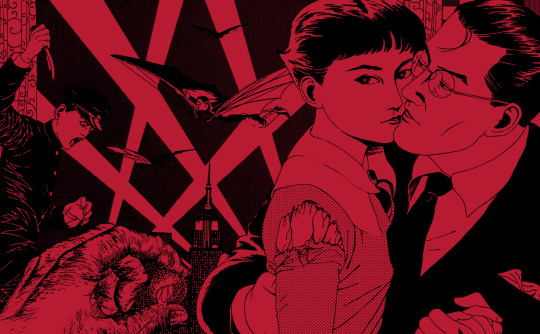
The Post-Futurist Fossils of LITCHI HIKARI CLUB
In a somewhat recent research tangent, while considering the possible “genealogy” of the Tokyo Grand Guignol’s themes and aesthetics, I made an interesting personal discovery regarding Litchi Hikari Club. Specifically some distinct thematic parallels that the play shares with the Italian futurist movement, less in relation to the art of the movement itself, but rather the ideologies of the movement’s controversial founder, Filippo Tommaso Marinetti, and his relation to the Italian fascist party. This is all of course in the context of understanding Litchi as a transgressive/dystopian horror story.
This is less of an absolute statement than it is a sort of open train of thought, so take things with a fair grain of salt. This is more or less just my own personal analysis of all the materials I could gather of the original play. Beyond inspecting the play as a possible allegory for futurism, there's also just a lot of general analysis of the play in relation to Ameya's overall body of work, both with the Tokyo Grand Guignol and also as a performance artist. I rarely put a 'keep reading' tag on these things since I'm an openly shameless product of the early days of blogging, but this one's a doozy (both in the information but also just the gargantuan length). Hopefully others will find it just as interesting.
The full essay is below...
The futurist movement itself was nothing short of an oddity. In their time, the futurists were pioneers of avant-garde modernist aesthetics, with their works ranging from deconstructive paintings to reality-bending sculptures and even early pathways to noise music with the creation of the non-conventional Intonarumori instruments of Luigi Russolo. Russolo’s own futurist-adjacent manifesto, The Art of Noises, would go on to influence such artists as John Cage, Pierre Henry, Einstürzende Neubauten and the openly left-wing industrial collective Test Department. When visiting the MOMA in New York City as a child, I was fascinated by Boccioni’s Unique Forms of Continuity in Space, a sculpture that appeared to be a spacetime malformation of the human figure encapsulated in a continual state of forward motion while in total stillness.
Despite this, the futurists were also a social movement of warmongering misogynists, with their own founding manifesto by Marinetti describing the bloodshed and cruelty of war as being “… the only cure for the world”. Their manifesto would also feature quotes such as “We want to demolish museums and libraries, fight morality, feminism and all opportunist and utilitarian cowardice”. They would originally pin anarchism as being their ideological ground in the manifesto, but shortly thereafter Marinetti would pick up an interest in fascism along with the politics of Benito Mussolini, going on to be a coauthor for the Italian fascist manifesto alongside the futurist manifesto. In consideration of how throughout most of World War II, modernist and post-modern works were considered “degenerate” forms of art in contrast with traditionalism, a whole avant-garde movement founded from fascist ideals is paradoxical. But for a period of time, that parallel wasn’t only in existence, but backed by Mussolini himself with there being a brief effort by Marinetti to make futurism the official aesthetic of fascist Italy.
One of the draws of futurism for Marinetti was an underlying sense of violence and extremity. According to Marinetti, his initial inspiration for the movement was the sensations he felt in the aftermath of a car accident where he drove into a ditch after nearly running over a band of tricyclists. He conceived his works to be acts of social disruption, intending to put people in states of unrest to cause riots and similar bouts of violence. “Art, in fact, can be nothing but violence, cruelty, and injustice”. He sought to destroy history to pave the way for a rapid acceleration to futuristic technological revelation.

“As shown in Edogawa Rampo’s Boy Detectives Club, young men like to hide from a world of girls and adulthood to form their own secret societies.” - June Vol. 27
In Litchi Hikari Club, a group of middle school-aged boys are faced with a crisis on the brink of puberty. At the twilight of their childhoods, they form a secret society known as the Hikari Club (or Light Club), a collective that’s devoted to the active preservation of their shared youth and virginity. The boys naively mimic an authoritarian organization and its hierarchy as they seek a means to preserve their boyhood, which they see as being idyllic in contrast to adulthood, a dreary state of existence that they call old and tired in the Usamaru Furuya manga version of the story. Similarly, in the Litchi Hikari Club-inspired short manga Moon Age 15: Damnation, the boys go on to liken their hideout with the paradisiacal garden of Eden. In said story, Zera would directly name the poem Paradise Lost in reference to the discovery of their hideout by adults (arriving in the form of ground surveyors) and the wide-eyed daughter of a land broker, with their contact to the virgin industrialized land being an ideological tainting of the sacred lair.
In their mission, they seek refuge in technological inhumanity by having their penises replaced with mechanized iron penises, symbolic devices of power and violence that can only procreate with other items of technology. Working in absolute secrecy, they collectively manufacture a robot known as Lychee. The purpose of Lychee, previously only known to Zera, isn’t revealed to the other club members until its completion. It’s when they unveil their “cute” robot in a scene that parallels the 1920 German expressionist film The Cabinet of Dr. Caligari that Zera tells the other members of Lychee’s purpose as a machine that would kidnap women for them. The robot's efforts are assisted by the girl capturing device, a strange rice cooker-shaped mask that’s laced with a sleeping drug. When questioned about the fuel source for the robot, Zera explains how it will run off the clean fuel of lychee fruits rather than an unsavory yet plentiful substance like electricity or gasoline as a means to further match the robot’s perceived beauty.
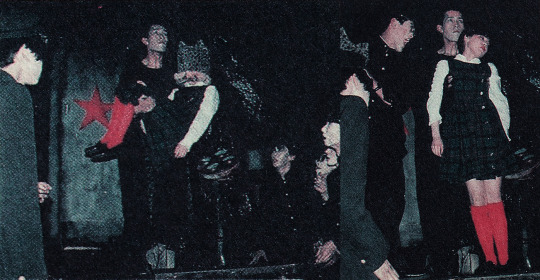
While the club share a general disdain for adulthood, they hold a special hatred to girls and women. Going off the dogmatic repulsion to sexuality that Kyusaku Shimada shows as the teacher in the Tokyo Grand Guignol’s prior play, Mercuro (1984), it could be assumed that the Hikari Club hold a similar dogmatic viewpoint about the vices of sex. In this context, it’s likely that they would’ve perceived women as being parasitic by nature as spreaders of the “old” and “tired” adult human condition through pubescent fixation and procreation. Sexual thoughts are inherent to aging for most people, given the process of discovering and exploring your identity throughout puberty. It’s that exact pubescent experience the club seek to eradicate.
Further insight is given to the Hikari Club’s dystopian psyche through their open allusions to nazi ideology. While Zera travels out to gather lychees from a tree he planted, the club get a special visit from a depraved elderly showman known as the Marquis De Maruo, performed by none other than Suehiro Maruo himself in the 1985 Christmas performance. Despite the club’s disposition to adults, they hold an exception for the Marquis for his old-timey showmanship and open pandering to the children’s whims. He always comes with autopsy films to show the young boys, and as they watch the gory videos he hands out candies that he describes as being a personal favorite of the late Adolf Hitler. He was said to also be the one to convince the boys to name their robot after the lychee fruit. It isn’t until Zera returns that the Marquis is removed from the hideout on Zera’s orders. Just before his exiling, he foretells to Zera the prophecy of the black star as both a promise and a warning to the aspiring dictator. It should be noted that there is a fascist occult symbol known as the black sun.

Suehiro Maruo as the Marquis De Maruo. On the right side is a caricature of Maruo as drawn by a contributor to June magazine, excerpted from an editorial cartoon in June Vol. 27 covering Litchi's 1985 Christmas performance.
In addition, the Marquis’ role alongside Jaibo’s appearances in the play (which I’ll get to later) show distinct parallels with the presence of the hobo in the Tokyo Grand Guignol’s first play, Mercuro. In Mercuro’s case, the hobo (performed by Norimizu Ameya, who would go on to also act as Jaibo) visits the classroom in secrecy to lecture the students his depraved ideologies. Whilst the hobo in Mercuro was a figure of perversion that existed in contrast to the teacher’s paranoid conservatism, in Litchi both Jaibo and the Marquis are enablers of the club’s fascistic leanings, with the Marquis being a promoter whereas Jaibo is a direct representation of the underlining perversions of fascist violence.
Though completely omitted from the Furuya manga, the element of the autopsy films shines a unique light on Zera’s death at the end of the story. In both the play and the manga, Zera is gutted alive by Lychee when the robot undergoes a meltdown after being forced to drown Kanon (Marin in the original play) in a coffin lined with roses. In the manga, Zera appears deeply unsettled when realizing his intestines resemble the internals of an adult. It’s unknown if this aspect is present in the theater version, as the full script remains unreleased to this day. It would fit however knowing not just the club’s repulsion to adulthood, but also how they retreat to technological modification to eradicate the human aspects they associate with adulthood. What is described of Zera’s death in the theater version has its own disquieting qualities as, from what’s mentioned, when confronted with his own mortality he appears to regress to a state of childlike delirium, a demeanor that’s drastically different from his usual calm and orderly presentation. Upon seeing his intestines, one of the responses he is able to muster is “I’m in trouble”. He says this as he questions whether or not he can fit his organs back inside the cavity before eventually telling himself that he’s just tired, that he “need(s) to sleep for a while”.

While never directly stated, it’s heavily implied that the club’s ideologies and technological fetishism ultimately root back to Jaibo, an ambiguously European transfer student who secretly manipulates the club’s actions from behind the scenes. Referred to by Hiroyuki Tsunekawa (Zera’s actor) as the “true dark emperor” of the Hikari Club, he was said to haunt the stage from the sides, closely inspecting the Hikari Club’s activities while keeping a distance. The iron phallus was first introduced by Jaibo through a monologue where he reveals how he fixed one to his own person, carefully describing its inner mechanisms and functionality before demonstrating its inhuman reproductive qualities by using the phallus to have sex with a TV. A television that he affectionately refers to as Psychic TV Chan, in reference to the post-industrial band fronted by Genesis P’Orridge. In the same scene, he promises the other members that they would all eventually get their own iron penises just like his own.
In a subsequent scene, he reveals the iron phallus’ use as a weapon when, arriving to the club’s base with a chained-up female schoolteacher who accidentally discovered the sanctuary, he uses the device to brutally kill the teacher through a mocking simulation of sexual intercourse. Just before raping her, he likens her to a landrace, bred for the sole purpose of reproducing and being processed into meat for consumption. He menacingly tells her that he will make her as “cut and dry” as her role in society before carrying out her execution. While there was some confusion on whether or not the iron phallus was a machine or solely a chastity device, it was found in bits of dialogue that the iron phallus at least shares the qualities of a pump with a described set of rubber hinges. The teacher’s death gruesomely reflects the death of Kei Fujiwara’s character in the later film Tetsuo: The Iron Man (1989), with the iron phallus mangling her insides as blood splatters across the stage. While the club treats adult sexuality as a plague, they manage to find through the iron phallus a way to convert their own states of chastity into a form of violence, stripping all humanity away from the penis and rendering it to a weapon of absolute power through desolate mechanized cruelty.
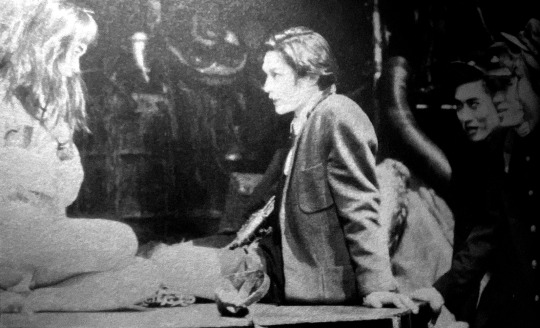
JAIBO: “Length, 250 mm, with a weight of 2.4 kilograms. Arm diameter, 30mm. Cylindrical thrust, 170mm… With pins, plates and rods of die-cast alloy. And hinges of rubber… the rest is pure iron. It is the iron phallus.” - June Vol. 27
In the same interview, Tsunekawa would go on to recall how the members of the Hikari Club were effectively Jaibo’s guinea pigs. In both the play and the manga, an after-school night of the long knives ensues with the slow collapse of the Hikari Club as Jaibo influences the exiling of certain club members, with Zera left ignorant to the social engineering as a mere extension of Jaibo’s elaborate puppeteering. Left embittered by a chess match where he lost to Zera, Tamiya is easily tricked by Jaibo into burning the lychee field as a way to get vengeance. Upon being caught, Tamiya is castrated of his iron phallus, resulting in his exiling from the club as a traitor while also being mockingly likened to a woman in the process. In another scene, it’s recalled that Jaibo and Zera exchange a conversation about the Hikari Club’s loyalty to Zera as they observe the outside world through their periscopes.
By all contemporary recollections, Jaibo was the club’s puppet master. He would’ve been the likely source of the club’s ideologies, the underlining hatred to women and fixation on technological violence, replacing mankind with a race of humanoid weapons. Zera would be a shell without his influence.
The presence of futurism could arguably even be rounded down to Lychee’s presence in the story. Beyond his theoretic work, Marinetti was also a playwright. He would be most well known for his futurist drama La donna è mobile, a story riddled with similarly perverse renditions of sexual violence. The play notably featured the presence of humanoid automatons a full decade before the term “robot” would be coined by Czechoslovakian author Karel Čapek in the play R.U.R., with the French version of Marinetti’s script referring to the machines as “puppets” for their visual similarity to humans.

All of this plays out over a soundscape that’s dominated by unnatural electronic frequencies and synthesized percussion. The sound design was arguably one of the most important aspects of Ameya’s plays, with Ameya at one point describing the Tokyo Grand Guignol productions as being an ensemble of his favorite sounds. The setting further compliments the atmosphere, made to resemble the internal of a junkyard or factory warehouse where heaps of technical jump decorate the stage around the monochrome cabinet that would eventually birth Lychee. Some of the featured artists in the play’s first act include Test Department, The Residents, 23 Skidoo and Deutsch Amerikanische Freundschaft. The play’s opening, which depicts the capturing and subsequent torture of a student named Toba through a so-called “baptism of light”, is underscored by the S.P.K. song Culturcide, a grim primordial industrial dirge that paints the image of a dystopia where the genocide of ethnic cultures is likened to the infection of human cells by parasitic pathogens. Instead of being hung with a noose, Toba is suspended by a meathook, left as a decoration amidst the heaps of mechanized excrement. He would eventually be joined by the lifeless bodies of various women the Hikari Club abduct as they’re steadily gathered in a small box at the back of the stage.
“Membrane torn apart, scavenging with the nomads. Requiem for the vestiges. Dissected, reproduced. The nucleus is infected with hybrid’s seed. Needles soak up, the weak must destroy. Cells cry out, cells scream out. Culturcide! Culturcide! Culturcide! Culturcide!” - Culturcide (from S.P.K.'s Dekompositiones EP)
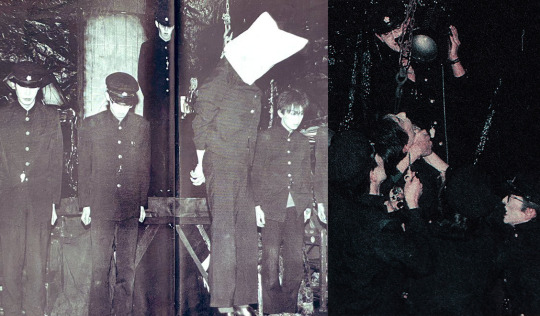
“We are now entering an era which history will come to call ANOTHER DARK AGE. But, in kontrast to the original Dark Age, defined by a lack of information, we suffer from an excess of information, which has been reduced to the repetition of media-generated signs. Through this specialization, it is no longer possible for an individual to attain a total view of society. Edukation is struktured to the performance of a limited number of funktions rather than for kreativity.”
“Kommunications systems are designed for the passive entertainment of the konsumer rather than the aktive stimulation of the user’s imagination. Through the spread of the western media, all kultures come to stimulate one another. By the end of the millennium, this biological infektion will have penetrated the heart of the most isolated traditions - a total CULTURCIDE.”
“Yet in every era, a small number of visionaries rise above the general malaise. Those who will succeed, will resist the pressure to become kommercialized “images”, demanding identifikation and imitation. They will uphold their principles in the face of impossible odds. By remaining anonymous, they will be free to develop their imagination with maximum diversity. For this is the TWILIGHT OF THE IDOLS, - the end of the proliferation of the ikons and the advent of a new symbolism.” - From the back cover of S.P.K.’s Dekompositiones EP (released under the moniker SepPuKu)
Over the course of the play, the story undergoes a drastic tonal shift as the focus moves from the Hikari Club’s hierarchical order and internal conflicts to the relationship between Lychee and Marin. Marin (performed by synthpop musician Miharu Koshi) was the first girl the Hikari Club successfully kidnap through Lychee after implementing the phrase “I am a human” in Lychee’s coding so it can understand the concept of human beauty. This small implementation causes a full unraveling in Lychee’s personality as it quickly forms a close bond with Marin, convinced that it is also a human like Marin. The soundscape changes alongside the overarching atmosphere, going from cold industrial drones and percussive electronica to ambient tracks. Some of the major scenes play out over moving piano-focused pieces and music box tunes from Haruomi Hosono’s soundtrack for Night on the Galactic Railroad. Originally created a weapon like the iron phalluses and the girl capturing device, Lychee is eventually defined in how he transcends from being a weapon to a conscious being with feelings. In this context, the play can be read as a juxtaposition of human emotion against inhuman futurist brutality.
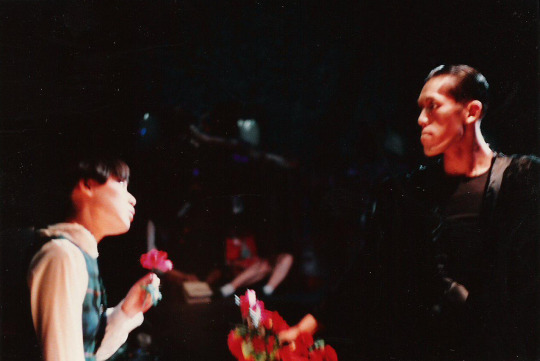
This split was likely the product of the radically different creative ideologies of Norimizu Ameya (the Tokyo Grand Guignol’s founder and lead director) and pseudonymous author K. Tagane (the playwright for the group from Mercuro to Litchi). Ameya had come into the group with radical intentions, holding Artaudesque aspirations to transgress the literary limits of modern theater to achieve something deeply subconscious. Meanwhile, Tagane was a romantic who was known for their poetic and lyrical screenplays. Ameya purportedly sought out Tagane’s screenplays specifically to find a literary base he would “destroy” in his direction, deconstructing the poeticisms in his own unique style. He describes it briefly in an interview regarding the stage directions of Mercuro, stating how he took elaborate descriptions of a lingering moon and ultimately deconstructed them to the moon solely being an illusion set by a screen projector, mapping out the exact dimensions of the projection to being a 3-meter photograph of the moon rather than a “fantastic moon”. It’s believed by some that the Tokyo Grand Guignol’s formation and ultimately short run were the product of a miraculous balance between Ameya and Tagane’s ideologies. It’s possible that Litchi could’ve been a last straw between the two artists. After Litchi, Tagane left the group, with Ameya having to write the troupe’s final screenplay on his own.
LYCHEE: “Marin is always sleeping… all she does is sleep. She doesn’t eat anything. Why does Marin sleep all day?”
MARIN: “When you’re asleep, all the sadness of the world passes over you.”

"The second half of Litchi was predominantly driven by the sounds of Ryuichi Sakamoto and Haruomi Hosono. During a scene that featured a piece from the Galactic Railroad soundtrack, Miharu Koshi sang to Kyusaku Shimada while dancing like a clockwork doll to the sounds of a twisting music box. The scene lasted for a while and was very romantic, the interactions between Lychee and Marin were all very sweet and cute. The second act of Litchi was all a product of Tagane’s making. By the time of the following play, Walpurgis, I was told by a staff member that Ameya had written the screenplay by himself because Tagane had left.”
“… While the first half was filled with repeated mantras and the unfolding aesthetics of an aspiring militia, the second half was immersed in the world of shoujo manga. It did appear that through the intermission, much of the junk and rubble around the podium was sorted out.”
“… The Tokyo Grand Guignol’s plays were always defined by a strong nocturnal atmosphere. But in Litchi’s second half, it wasn’t a dark night, but a brightly lit one under the moonlight and plentiful stars in the sky shining through an invisible skylight. Marin doesn’t forgive Lychee immediately for his actions, responding to him harshly in a way that would confuse him and make him sulk. It came across as a somewhat bitter reimagining of a French comedy like Louis Malle’s Zazie dans le Métro or Jean-Pierre Jeunet’s Amélie, it was different that way in how it wasn’t only Maruo’s inferno.” - From a Twitter thread by user Shoru Toji regarding the 1986 rerun of Litchi Hikari Club
Some questionable qualities do exist in the relationship between Lychee and Marin. What should be a peaceful retreat from the dystopian corruption still has a sinister undertone in the disparities between Lychee’s cold masculine features in contrast with Marin’s childlike girly innocence. It doesn’t help that Zazie dans le Métro (one of the mentioned films in the recollection) was directed by Louis Malle, who while known for such films as My Dinner With Andre and Black Moon was also responsible for the infamously discomforting Pretty Baby. Then again, Litchi was the product of a confrontational transgressive subculture, so the sinister undertones could be intentional. Keep in mind the contents of Suehiro Maruo’s prolific adaption of Shōjo Tsubaki and how it unflinchingly depicts abuse and manipulation through the eyes of a confused child.
It could be possible that Lychee himself was intended to be childlike in its mannerisms. Throughout the existing descriptions, Lychee was shown as speaking in fragmented sentences while struggling to understand basic concepts. Zera was mentioned to also use certain phrases like “cute” when referring to the robot when it was unveiled. And it’s through Marin that Lychee learns morality like a child. The robot’s masculinity could be passed off as the cast all being adults. Hiroyuki Tsunekawa for instance shows distinctly sculpted features from certain angles when performing Zera.

In his aspirations to become a human, Lychee eventually “dies” like a human. With the burning of Zera’s lychee tree, the robot is left with a finite limit on its remaining energy before it totally loses consciousness. After his rampage, Lychee attempts to reunite with Marin, but he runs out of fuel. Before what should be a moment of resolution, things are cut short as the stage goes black, eventually illuminated to show an unpowered Lychee cradling Marin’s corpse in his arms. Zera reemerges to observe the remnants of Lychee and Marin. He speaks of how Lychee will crumble into nothingness alongside Marin for foolishly giving into human emotion, further implying the club’s views on humanity. After this, recollections of the play’s final lines differentiate somewhat. It was said that in the original Christmas performance, Zera calls out to Jaibo, posing the corpses of Lychee and Marin as being his seasonal gifts to Jaibo. Whereas in most popular recollections, it’s described that after his monologue, Zera shouts “Wohlan! Beginnen!” (German for “Now! Begin!”) before prompting the decorations across the stage to collapse, revealing a set of stepladders from behind that the remaining previously deceased club members stand, all drenched in blood with spotlights illuminating their faces from below.
ZERA: “And with that, our tale of a foolish romance between woman and machine reaches its conclusion. It ends before me as I stand here, watching. Lychee, the machine, will rust away into dust. And Marin, a young girl, will rot away leaving behind only her bones, which too will crumble…”
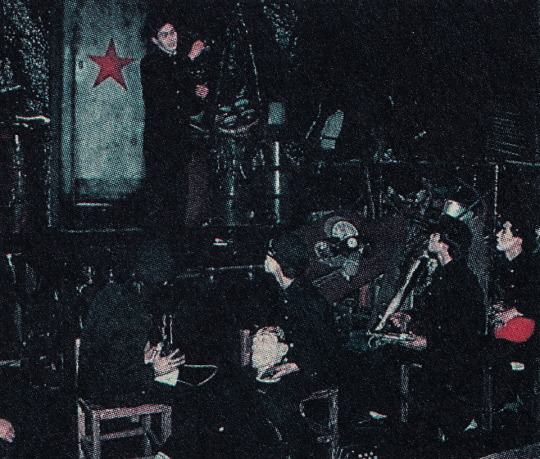
Multiple readings can be deciphered from this conclusion. The most established theory is in relation to the Hikari Club’s aspirations for eternal youth, with the members technically achieving their goal through the stagnation of death. They will remain eternal children since they died as children, unable to ever grow into adulthood. In the context of futurism and mechanized fascism however, it could be read as a bitter observation of a lasting dictatorship. With how the Hikari Club members had rendered themselves less human than their own robot, they survive death to continue their work, seeking to one day eradicate humanity in favor of a race of sentient childlike weapons.
“To admire an old picture is to pour our sensibility into a funeral urn instead of casting it forward with violent spurts of creation and action. Do you want to waste the best part of your strength in a useless admiration of the past, from which you will emerge exhausted, diminished, trampled on?”
“… For the dying, for invalids and for prisoners it may be all right. It is, perhaps, some sort of balm for their wounds, the admirable past, at a moment when the future is denied them. But we will have none of it, we, the young, strong and living Futurists! Let the good incendiaries with charred fingers come! Here they are! Heap up the fire to the shelves of the libraries! Divert the canals to flood the cellars of the museums! Let the glorious canvases swim ashore! Take the picks and hammers! Undermine the foundation of venerable towns! The oldest among us are not yet thirty years old: we have therefore at least ten years to accomplish our task. When we are forty let younger and stronger men than we throw us in the waste paper basket like useless manuscripts! They will come against us from afar, leaping on the light cadence of their first poems, clutching the air with their predatory fingers and sniffing at the gates of the academies the good scent of our decaying spirits, already promised to the catacombs of the libraries.” - from the 1909 Futurist Manifesto by Filippo Tommaso Marinetti

I forgot what exactly first caused the parallel to cross my mind. I do recall it being reignited when having a closer look over the poster and flyer for Litchi’s Christmas performance in December 1985. The flyer in particular is really a wonderful thing to look at. Predominantly featuring an art spread by Suehiro Maruo, a suited man with Kyusaku Shimada’s likeness is shown caressing a girl in front of a modernist cityscape with spotlights shining up to a night sky. Other suited men in goggles fly in the air with Da Vinci-reminiscent flying apparatuses between the beams of the metropolis’ spotlights. A student in full gakuran uniform flings himself into the scene from the far left side of the image with a dagger in hand, and a larger hand comes from the viewer’s perspective holding a partially peeled lychee fruit. While not based on any direct scene from the play, it perfectly instills the play’s atmosphere with an air of antiquated modernity, like the numerous illustrations of the early 1900s that show aspirational visions of what a futuristic cityscape might resemble. The bizarre neo-Victorian fashions of the future and its post-modernist formalities. The term futurism came to mind somewhat naively from this train of thought. It was a movement I recalled hearing about, but my memory of it was hazy. It wasn’t until I went in for a basic refresher that I felt the figurative lightbulb go off in my head. That was when the pieces started to come together, but then also strain apart from each other into tangents.
Granted, many of these parallels could be read as coincidental. Many of them can even be passed off the play being a work of proto-cyberpunk, knowing how Tetsuo: The Iron Man would subsequently explore similar themes of cybernetics and human sexuality. It should still be noted however that in contrast with many of the Japanese cyberpunk films, Litchi was explicit in its connotations between technological inhumanity and fascism, with the machinery itself being the iconography of a dictatorship rather than a product of it. In addition, with Tetsuo the film has strong gay overtones, with the technology being an extension of the sexual tensions between the salaryman and the metal fetishist. For a period of time, efforts were made to make futurism the official aesthetic of fascist Italy, and modern fascism as we know it is in the same family tree of Italian philosophy as futurism. The Hikari Club are explicit in drawing from German aesthetics rather than Italian however, speaking in intermittent German and predominantly using German technology. The spotlight that they used when torturing Toba in the first act, for example, was a Hustadt Leuchten branded spotlight. And if that isn’t a German name I don’t know what is. It was also said that Jaibo’s outfit in the play was modeled after German school uniforms. Though then again, the Tokyo Grand Guignol’s works were a bit of a cultural slurry. Jaibo’s name for example is Spanish (derived from Luis Buñuel’s Los Olvidados), while the character is implied to be German.
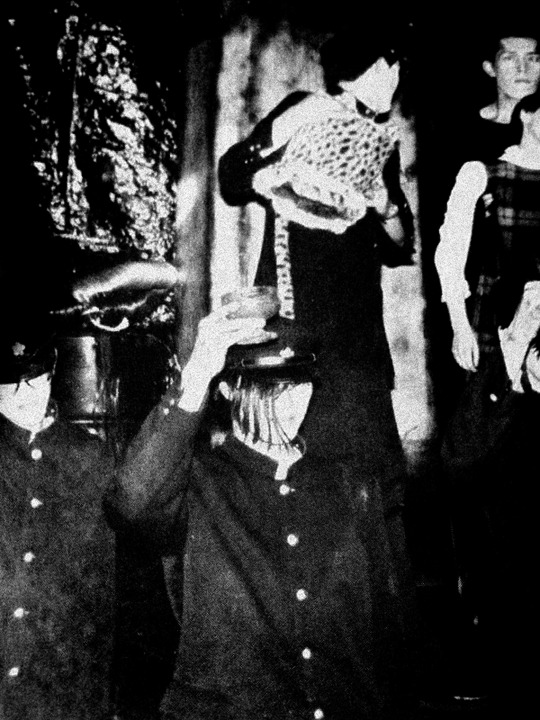
Similar to the cited origins of futurism, Ameya stated in a 2019 tweet regarding the June 9th, 1985 abridged Mercuro performance on Tokumitsu Kazuo’s TV Forum that in the following August of that year, an airplane accident occurred that led to the conception of Litchi’s screenplay. The exact nature of the accident was never specified, but the affiliates he was communicating with all appeared to be familiar with it and expressed concern when it was brought up. This was however one of an assortment of influences that were cited behind Litchi’s production, with the two more established theories regarding the then-contemporary mystique around lychee fruit in Chinese cuisine along with the play being a loose adaption of Kazuo Umezu’s My Name is Shingo.
For what it’s worth, the themes of Litchi, along with the Tokyo Grand Guignol’s other works, were closely tied with certain concepts that Ameya personally cultivated throughout his career. A frequent recurring topic Ameya would bring up in relation to his works was the nature of the human body in relation to foreign matter, need it be biological or unnatural. With Mercuro the students taught by Shimada are made into so-called Mercuroids by having their blood supplies replaced with mercurochrome, a substance that is referred to as the “antithesis of blood” by Shimada while in character. In an interview for the book About Artaud?, Ameya cites an interest in Osamu Tezuka’s manga in how certain stories of Tezuka’s paralleled Ameya’s observations of the body. He directly names Dororo and Black Jack, observing how both Hyakkimaru and Black Jack reconstructed their bodies from pieces of other people, going on to bluntly describe Pinoko as a “mass of organs covered in plastic skin”.

A section from June Vol. 27 highlighting some of the more established performers from Litchi's 1985 Christmas performance. The actors from left to right are Norimizu Ameya as Jaibo, Naomi Hagio as the female school teacher (best known in cult circles for her role as Kazuyo in the 1986 horror film Entrails of a Virgin), Suehiro Maruo out of costume and Miharu Koshi as Marin.
During his temporary retirement from theater, Ameya would take up performance art, with some of his performances revolving around acts with his own blood. While my memories of these works are a bit hazy, I remember one action he performed that involved a blood transfusion, with the focus being on the experience of having another person’s blood coursing through your veins. While I didn't have much luck relocating this piece (probably from it not being covered in English), I did find on the Japan Foundation’s page for performing arts an interview where Ameya discusses being in a band with Shimada where Ameya had blood drawn from his body while he played drums. He would also describe an art exhibition where he displayed samples of the blood of a person infected with HIV.
“After 1990 he left the field of theatre and began to engage himself with visual arts - still proceeding to work on his major topic - the human body - taking up themes like blood transfusion, artificial fertilization, infectious diseases, selective breeding, chemical food, and sex discrimination, creating works as a member of the collaboration unit Technocrat.” - Performing Arts Network Japan (The Japan Foundation)
There are still an assortment of open questions I’m left with in regards to the contents of the original Litchi play. One of the most glaring ones is Niko’s eye. In consideration of Ameya’s interest in the body, the detail would fit perfectly with his ideologies. A club member who, to show his absolute loyalty to the Hikari Club, has his own eyeball procedurally gouged out to be made a part of the Lychee robot. Despite this perfect alignment, none of the contemporary recollections mention this element. While Niko does have an eyepatch in certain production photos, it never seems to come up as a plot point. He isn’t the only one to bear an eyepatch either, with Jacob also being shown with an eyepatch in flyers. More questions range from Jaibo’s motives in causing the dissolution of the Hikari Club to the true nature of Zera’s affiliation to Jaibo. While Tsunekawa has stood his ground in the relationship between Zera and Jaibo being totally sexless, in the cited volume of June the editor playfully refers to Jaibo as being Zera’s “best friend” in quotes.
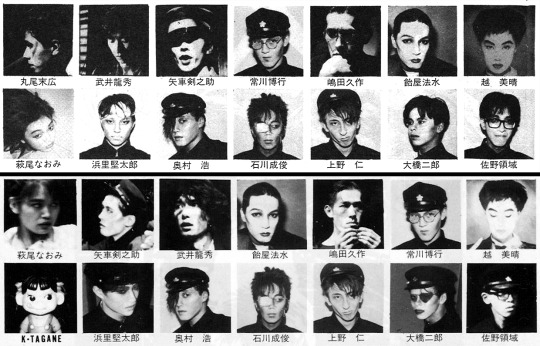
A side-by-side comparison of the cast listings on the back of the flyers for the December 1985 performance of Litchi Hikari Club alongside its 1986 rerun. The 1985 run's lineup is at the top while the 1986 run is at the bottom.
Much speculation is naturally involved when looking into the original Litchi Hikari Club since it is in essence a cultural phantom. There’s a reason I used the term genealogy in relation to my research of the Tokyo Grand Guignol’s works. It is an artistic enigma as while its presence lingers in subculture, the original works are now practically unattainable due to the inherent nature of theater. As Ameya himself would acknowledge in another interview, theater is an immediate medium that can only be perceived in its truest form for a very short span of time before eventually disintegrating. So with the Tokyo Grand Guignol’s plays, you are left to scour through the scattered remnants and contemporary recollections alongside the figurative creative descendants of the plays. You analyze the statements of both the original participants and the people they openly dismiss, as even those people were original audience members before reinterpreting the plays to their own unique visions. Despite the apparent differences, I still feel that Furuya’s manga gives a unique perspective to the story when viewed under dissection. That is if you want to see it in strict relation to the play. Outside that, I feel it firmly stands on its own merits. I like the manga no matter what Tsunekawa says, that’s what I’m trying to say. Ameya approved it anyway.
It took me a full day to write all this out, and like the first time I went down this train of thought, I’m pooped. During that first excursion, after excitedly spiraling through these potential connections, I noticed in passing mention something about Marinetti’s cooking. You see, later in his life Marinetti aimed to apply futurism not just to art and theater, but cuisine also. As an Italian, Marinetti openly despised pasta, seeing it as being an edible slog that weighs down the spirits of the Italian people. Just further evidence that I would never get along with the man, no matter my liking of the Boccioni sculpture I saw at MOMA all those years ago. Well, outside of him being a fascist and all obviously. I like pasta. Either way, he was on a mission to conceive all-new all-Italian cuisines that would match the vision he had of a new fascist Italy. Nothing could prepare me though for when I saw an image of what would best be described as a towering cock and ball torture meat totem. It is exactly as it sounds, a big phallic tower of cooked meat with a set of gigantic dough-covered balls of chicken flesh on the front and back where you have to stick needles through the thing to hold it together. Words cannot express just how big it is. The thing was damn well near falling apart from how unnatural its shape was, and you’re expected to eat it while it has honey pouring from the tip of the tower. I genuinely winced watching its assembly, I instinctively crossed my legs somewhat when it was pierced by wooden sticks and then cut into sections to reveal the plant-stuffed interiors. As a person with no interest whatsoever in cooking shows, I was on the edge of my seat watching a PBS-funded webisode of someone preparing futurist dishes. Seek it out for yourself, it’s an excessively batshit culinary freakshow.
That is more than enough talk about penises for the rest of the week. I’m going to spend the next few days looking at artistic yet selectively vaginal flowers to balance things out, equal opportunity symbology.

131 notes
·
View notes
Text
It is essential to practice reading as an art.
Friedrich Nietzsche - 'The Genealogy of Morals'
51 notes
·
View notes
Text
The last two Silmarillion Daily posts have gotten me thinking about the War of Wrath again, specifically these points:
Why didn't the Elves remaining in Beleriand fight in the War? Were they tired, incapable, unwilling, or prevented from fighting by the Host of the Valar? Also notable is that Gil-galad is High King of the Noldor at this point, regardless of his genealogy, and working to maintain refuges for the Eldar. And given that this war shook the ground and spanned the entirety of Beleriand, there's no way they didn't know about it.
For that matter, why did the Edain fight when the Elves didn't?
This war took forty years. With its large scale and the ensuing destruction of the land, conditions must have been dire by the end - lack of supplies, low morale... The Siege of Angband lasted 400 years, but they didn't have to supply enough resources for an army that can cover an entire continent, and the land was more hospitable then.
How was the Host of the Valar ready to fight so soon? As far as we know, the Vanyar have never been involved in any combat. The Noldor wouldn't have had much experience in fighting or strategy either. This means that either: 1) at some point in First Age Valinor something occured to make the inhabitants arm themselves and learn to fight; 2) in the span of 1-2 years they gave themselves a crash course and procured all their resources, possibly assisted by the Valar (which is possible, depending on whether or not time passes differently in Valinor); or 3) the grand Host of the Valar was severely underprepared upon arriving to Middle-earth.
What were Elrond and Elros doing all those years? Did Earendil ever see them again?
#silmarillion daily#also we have almost *no details* about how the war actually went aside from a few incidents#war of wrath#finarfin#ingwion#eonwe#valinor#beleriand#gil-galad#silmarillion#tolkien
88 notes
·
View notes
Text
All sufferers have an awful resourcefulness and ingenuity in finding excuses for painful emotions; they even enjoy their jealousy, their broodings over base actions and apparent injuries, they burrow through the intestines of their past and present in their search for obscure mysteries, wherein they will be at liberty to wallow in a torturing suspicion and get drunk on the venom of their own malice-they tear open the oldest wounds, they make themselves bleed from the scars which have long been healed, they make evildoers out of friends, wife, child, and everything which is nearest to them.
'I suffer: it must be somebody's fault'-so thinks every sick sheep. 'Quite so, my sheep, it must be the fault of someone; but thou thyself art that someone-it is all the fault of thyself alone-it is the fault of thyself alone against thyself.'
Friedrich Nietzsche, Genealogy of Morals
68 notes
·
View notes